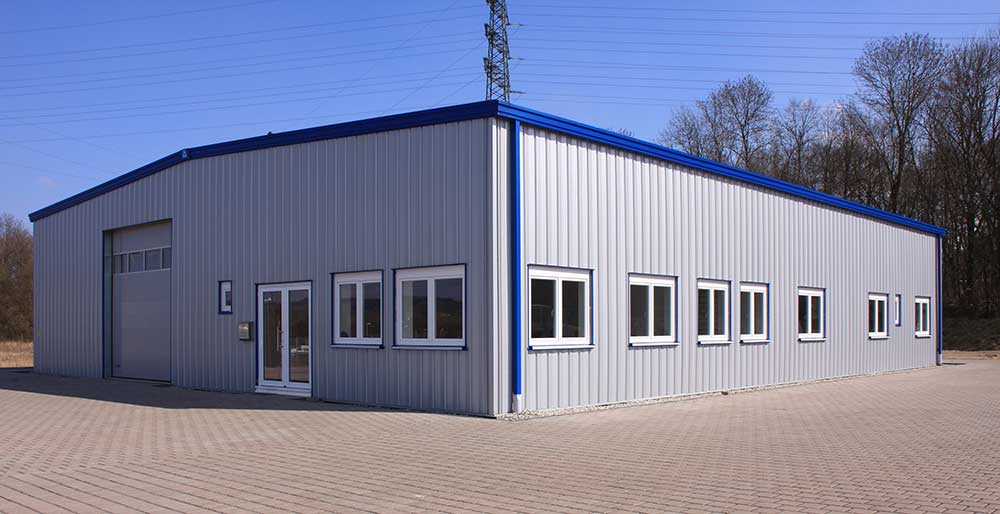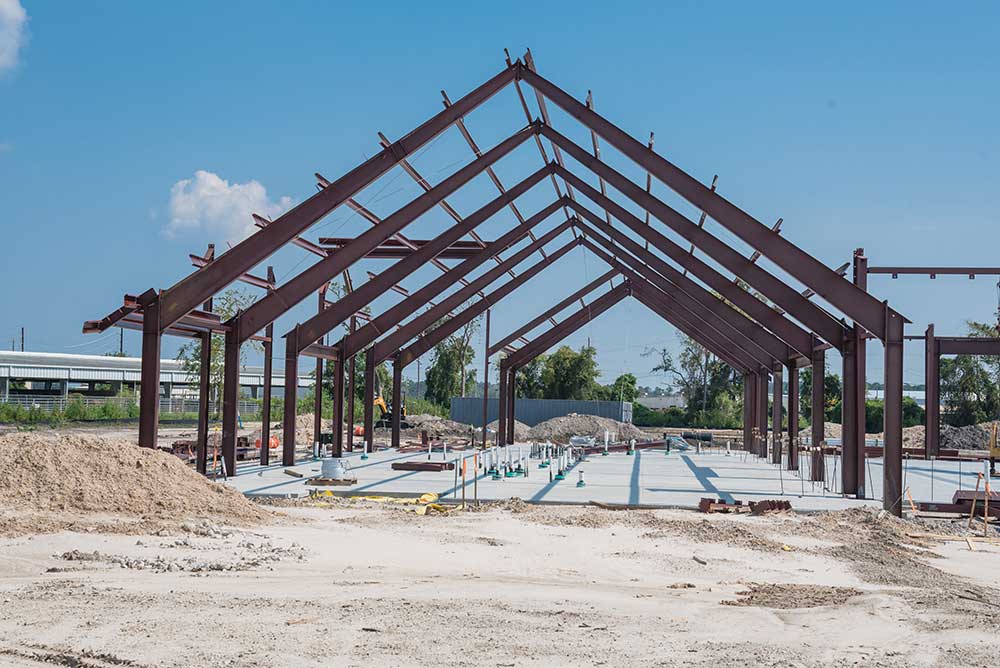Streem Company designs and constructs commercial and residential metal buildings. Metal buildings have many uses in both settings and are often an economical and secure solution.
Versatile & Economical Solutions
Metal buildings are incredibly versatile and find applications in various industries and purposes. They are commonly used as warehouses and distribution centers, providing large, open spaces for storage and logistics operations. Manufacturing facilities opt for metal buildings due to their quick construction, ability to house heavy machinery, and potential for future expansion. In the commercial sector, metal buildings serve as retail stores, offices, restaurants, and shopping centers, offering flexibility in design and cost-effectiveness. Agricultural businesses utilize metal buildings as barns, equipment sheds, and livestock shelters, benefitting from their durability and resilience to harsh weather conditions. Aircraft hangars also make use of metal buildings for safely storing and maintaining aircraft.

Metal buildings extend their utility to sports and recreation facilities, serving as indoor sports complexes, gyms, and recreational centers. Educational institutions incorporate them as classrooms, laboratories, and gymnasiums. They are occasionally used for religious buildings, healthcare facilities, self-storage units, and automotive repair shops. Government and military facilities utilize metal buildings for storage, training centers, and temporary housing needs. They are also adapted for recreational purposes, community centers, and event venues. Moreover, metal buildings can be transformed into greenhouses for plant cultivation. While less common, some residential homes are constructed using metal building materials, taking advantage of their durability and potential energy efficiency. Overall, the versatility, speed of construction, and cost-effectiveness of metal buildings make them a preferred choice for a wide range of applications in various industries.
Advantages of Metal Buildings:
Cost-Effectiveness: Metal buildings often require less material and labor compared to traditional structures, leading to cost savings during construction.
Speed of Construction: Prefabricated metal components and straightforward assembly techniques enable faster construction, reducing project timelines significantly.
Versatility: Metal buildings can be customized to suit various applications, including commercial, industrial, agricultural, and residential uses.
Durability and Strength: Steel and other metal materials offer high structural strength and resistance to weather elements, fire, pests, and decay.
Clear-Span Design: Metal building frameworks often allow for open and unobstructed interiors, providing flexible floor plans and maximizing usable space.
Sustainability: Metal is recyclable, making metal buildings an eco-friendly option. Additionally, metal structures can incorporate energy-efficient features.
Minimal Maintenance: Metal buildings require less maintenance over their lifetime compared to structures made of wood or masonry.
Longevity: When properly constructed and maintained, metal buildings can have a longer lifespan than some traditional structures.
Disadvantages of Metal Buildings:
Thermal Conductivity: Metal can conduct heat, making metal buildings more susceptible to temperature fluctuations unless properly insulated.
Condensation Issues: In certain environments, metal buildings may experience condensation buildup, potentially leading to corrosion if not addressed.
Aesthetics: Some people may find the appearance of metal buildings less visually appealing compared to traditional structures.
Sound Transmission: Metal surfaces can amplify sound, so additional soundproofing may be necessary in certain applications.
Design Limitations: While metal buildings offer versatility, certain architectural designs may be easier to achieve using traditional construction methods.
Metal Building Construction Process

Metal building construction involves several stages, from site preparation to the actual assembly of the metal structure. Each step is crucial in ensuring a successful and safe construction process. Here’s a breakdown of the key aspects involved:
- Site Preparation:
- Clearing the site: Remove any obstacles, debris, vegetation, and leveling the ground to create a suitable foundation.
- Soil testing: Conduct geotechnical testing to assess the soil’s bearing capacity and determine if any special foundation requirements are necessary.
- Surveying: Accurately mark the boundaries and layout of the building on the site.
- Foundation Types:
- Slab-on-Grade: A common choice for metal buildings, where a concrete slab is poured directly on the prepared ground.
- Pier and Beam: Concrete piers or footings are placed at specific points to support the metal building structure.
- Trench Foundation: Trenches are dug and filled with concrete to create a foundation for the walls.
- Pre-Engineered Components:
- Many metal building components are pre-engineered and fabricated off-site, including mainframes, secondary framing, wall panels, roof panels, and accessories.
- These components are designed to fit together precisely, allowing for faster and more efficient assembly.
- Safety Considerations:
- Personal Protective Equipment (PPE): All workers involved in the construction should wear appropriate PPE, including hard hats, gloves, safety glasses, and steel-toed boots.
- Equipment Safety: Proper training and precautions should be followed while using heavy machinery, cranes, and other equipment during the construction process.
- Fall Protection: Safety is important, we implement features such as guardrails, safety nets, and personal fall systems to prevent falls from heights.
- Structural Stability: Ensure the stability of the partially assembled structure to avoid accidents during construction.
- Assembly Techniques:
- Erection of Frames: Mainframes are erected first, which form the primary structural support of the building. These frames are often bolted or welded together.
- Secondary Framing: Secondary components like purlins, girts, and eave struts are installed, connecting and supporting the mainframes.
- Wall and Roof Panel Installation: Panels are attached to the secondary framing to form the walls and roof of the building. Proper sealing and weatherproofing are essential.
- Doors and Windows: Install doors, windows, and other accessories according to the building design.
- Electrical and Plumbing:
- If required, electrical wiring and plumbing systems are installed during the construction process.
- Insulation and Finishing:
- Insulation materials are added to the building to improve energy efficiency and provide climate control.
- Finishing touches like interior walls, ceilings, and flooring are added as needed.
- Quality Control and Inspection:
- Regular inspections are conducted throughout the construction process to ensure that all components are correctly installed and meet safety standards.
- Final Inspection and Handover:
- Before occupancy, a final inspection is carried out to verify that the building is safe and compliant with regulations.
- Once the metal building passes inspection, it can be handed over to the owner for use.
Metal building construction offers several advantages, including cost-effectiveness, speed of construction, and versatility. However, proper planning, adherence to safety protocols, and skilled workmanship are crucial to ensuring a successful and durable metal building project.
Metal Building FAQ
Metal buildings are structures made primarily from metal components, such as steel or aluminum. They are pre-engineered, fabricated off-site, and then assembled on-site, providing a cost-effective and versatile construction solution for various applications.
Some key advantages of metal buildings include cost-effectiveness, quick construction, durability, strength, versatility in design, energy efficiency, and low maintenance requirements.
Metal buildings find applications in a wide range of industries and purposes, including warehouses, manufacturing facilities, commercial buildings, agricultural structures, aircraft hangars, sports facilities, educational institutions, self-storage units, automotive repair shops, and more.
The construction time for a metal building varies depending on its size, complexity, and site conditions. However, metal buildings are generally quicker to erect compared to traditional construction methods, with some projects taking weeks instead of months.
Yes, metal buildings are highly customizable in design. They can be tailored to fit specific architectural requirements, and various finishes, colors, and accessories can be incorporated to achieve the desired aesthetics.
Metal buildings can be made energy-efficient through proper insulation and incorporating features like cool roofing materials and energy-efficient doors and windows.
Yes, reputable metal building manufacturers design their structures to meet or exceed local building codes and safety standards. Proper engineering and adherence to regulations ensure that metal buildings are safe and structurally sound.
Yes, one of the advantages of metal buildings is their ability to accommodate future expansions and modifications easily. Their design allows for seamless integration of additional space or features.
Metal buildings can be considered environmentally friendly due to the recyclability of metal materials. They can also incorporate energy-efficient features to reduce their environmental impact.
Metal buildings generally require minimal maintenance. Regular inspections, cleaning, and addressing minor repairs can help ensure the longevity of the structure.
Yes, metal buildings need foundations to provide a stable and level base. The type of foundation varies depending on the specific project and site conditions.
Yes, metal buildings are known for their durability and resistance to various weather elements, including wind, snow, rain, and even seismic activity when properly engineered.
Metal itself is not flammable, and metal buildings can be designed to meet fire-resistant requirements by incorporating appropriate fire-rated materials and insulation.
Yes, in many cases, metal buildings can be disassembled and moved to a different location, making them a flexible and portable construction option.
The lifespan of a metal building depends on factors such as design, maintenance, and environmental conditions. With proper care, metal buildings can last several decades or more.
Metal Buildings are a great solution with many applications, if you are in search of a company to build a metal building from start to finish, give Streem Company a call today.
